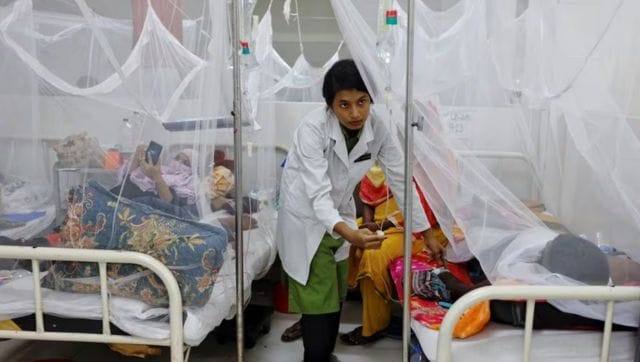The Global Dengue Outbreak: 5 Million Cases and 5,500 Deaths
The year is coming to an end, and the dengue outbreak across the globe shows no sign of abating. With over five million cases and 5,500 deaths so far, the vector-borne disease has caused alarm among governments and public health experts. While dengue has traditionally been considered native to warm climatic areas, it is now emerging in regions where it was previously unheard of, including parts of the US and Europe.
An analysis by Save the Children revealed that 2023 has seen five million cases of dengue fever, a significant increase compared to the last five years. The infections were reported across 20 of the worst-impacted countries between January and November 2023. The report stated that this marked a 30 per cent increase in cases compared to 2022 and an 18 per cent jump from the figures in 2019, which saw a major outbreak.
Dengue deaths in 2023 have also been on the rise, killing at least 5,500 people across the 20 countries, up 32 per cent from 2022 and 11 per cent higher than in 2019. However, the actual number of deaths and cases is likely to be far higher, as many cases are not reported.
California reported its first locally-transmitted case of dengue virus in October, and Sudan’s capital, Khartoum, reported a patient infected with the disease for the first time in March. The Pan-American Health Organization released a risk assessment report, stating that 2023 has the highest historical record of dengue cases in the Americas, with more than 4.1 million new infections reported. This figure exceeded those of 2019, which recorded over 3.1 million cases, including 28,203 serious cases and 1,823 deaths.
Bangladesh faced its worst dengue fever outbreak in 2023, with over 300,000 people infected since January, according to Save the Children’s analysis. This marked a massive spike from the 62,000 cases reported in 2022. Additionally, Bangladesh reported 1,598 dengue deaths, including over 160 children (mostly aged below 10), making it the highest known global causality due to the disease and more than five times higher than in 2022.
In Peru, at least 50 children died and another 80,300 were infected with dengue this year in the worst epidemic the country has seen in over a decade. The country recorded more than 270,000 cases of dengue in 2023, almost four times the 74,000 cases in 2017, the last El Niño year in the country.
Burkina Faso in West Africa reported 511 dengue deaths this year, marking a sharp rise from the 18 deaths reported in 2017 and 15 in 2016, the last years for which data is available. According to the country’s Ministry of Health, probable cases are at almost 50,000. The lack of robust dengue surveillance and management systems raises concerns about potential undetected cases or unrecorded travel movements contributing to unnoticed disease spread, said the Pan-American Health Organization in its assessment report.
The World Health Organization (WHO) report indicated that about half of the world’s population is now at risk of dengue, with an estimated 100–400 million infections occurring each year. Currently, there is no antiviral treatment for dengue, and precaution, as well as timely diagnosis, along with medication, can help manage the symptoms of the disease.
Dengue is most commonly spread through infected female Aedes aegypti (Egyptian tiger) mosquitoes that breed in stagnant water. The disease can also be transmitted from pregnant women to their babies and, in rare cases, through blood transfusions, organ transplants, or needle injuries. Dengue has long been a public health concern in Asia and Latin America and recently has seen a surge attributed in part to the resurgence of global travel after the COVID pandemic. This year’s El Niño weather phenomenon, which contributes to warmer temperatures, is also believed to have exacerbated dengue outbreaks in tropical countries.
Dengue, also known as break-bone fever, is a viral infection spread from mosquitoes to people. Most infected individuals do not show symptoms, but those who do may experience high fever, severe headache, pain behind the eyes, muscle and joint pains, nausea, vomiting, swollen glands, and rash. These symptoms usually begin 4–10 days after infection and last for 2–7 days. Those infected for the second time are at greater risk of severe dengue, which can be fatal. Severe dengue symptoms often come after the fever has gone away and include severe abdominal pain, persistent vomiting, rapid breathing, bleeding gums or nose, fatigue, restlessness, blood in vomit or stool, being very thirsty, pale and cold skin, and feeling weak. After recovery from dengue, people may feel tired for several weeks.
To reduce the risk of dengue, it is important to avoid mosquito bites, especially during the day. Most cases of dengue fever can be detected early and treated at home by administering pain medicines, as there is no specific treatment for dengue. Acetaminophen (paracetamol) is often used to control pain. Non-steroidal anti-inflammatory drugs like ibuprofen and aspirin are to be avoided, as they can increase the risk of bleeding. For people with severe dengue, hospitalization is often needed. There is a vaccine called Dengvaxia for people who have had dengue at least once and live in places where the disease is common.
Source link


